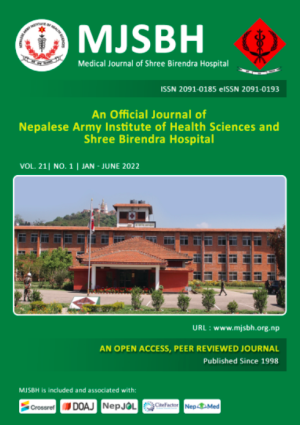Correlation of Intraocular pressure and Visual Field Defects in Primary Open Angle Glaucoma
Keywords:
primary open angle glaucoma, intraocular pressure, goldmannn applanation tonometer, visual field defect, humphrey visual field, mean deviationAbstract
Aim: To correlate between intraocular pressure (IOP) with visual field pattern in primary open angle glaucoma (POAG).
Methods: Pretreatment IOP at presentation was measured in 94 eyes of patients diagnosed with POAG in a descriptive correlational study. At least two Humphrey Visual Field(HVF) assessment two weeks apart was performed. Glaucomatous visual field defect and its severity was diagnosed on the basis of Hodapp-Parrish-Anderson criteria. The relationship between visual field defect and IOP were analyzed.
Results: Superior arcuate scotoma was most common visual field defect seen in 18(19.1%) eyes. 56 eyes (59.6%) had mild POAG (MD of <-6dB) with no cases having double arcuate scotoma whereas 1 eye (16.0%) with moderate POAG (MD of -6 to -12dB) had 1 double arcuate scotoma and 23 eyes (24.5%) with severe POAG (MD of >-12dB) had 14 double arcuate scotoma. The mean IOP in mild POAG was 24.29 mmHg (range 21-30); 26.40mmHg (range 22-31) in moderate POAG and 29.70 mmHg (range 22-36) in severe POAG. Significant relation was demonstrated between elevated IOP at presentation and higher negative values of MD (p<0.001).
Conclusions: Higher IOP at presentation is associated with severity of POAG. Aggressive treatment should be initiated to arrest the rate of progression.
Downloads
Downloads
Published
How to Cite
Issue
Section
License
Copyright (c) 2022 Medical Journal of Shree Birendra Hospital

This work is licensed under a Creative Commons Attribution-NonCommercial-NoDerivatives 4.0 International License.
This license enables reusers to distribute, remix, adapt, and build upon the material in any medium or format for noncommercial purposes only, and only so long as attribution is given to the creator.




